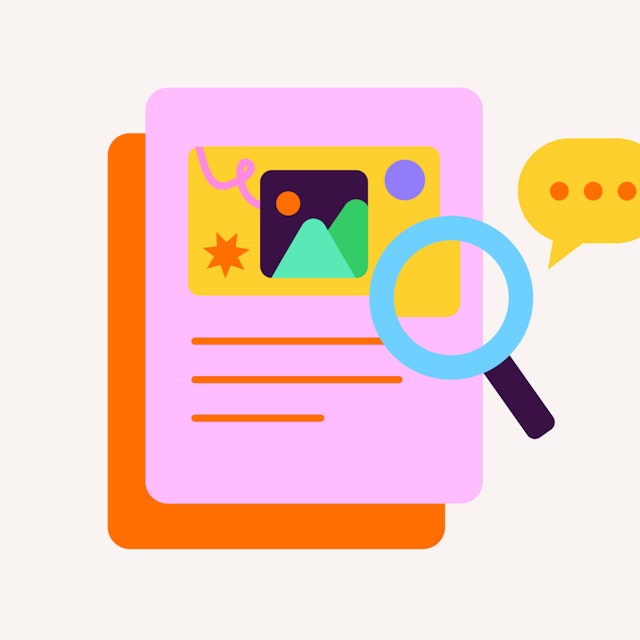Learning Basic SEO for Creatives
Demystify SEO and grow your creative brand online
Written byCallie Hawley
Updated onJune 4, 2025

“SEO is only for big companies.”
That might have been easy to believe ten years ago. But today? It couldn’t be further from the truth.
If you’re a designer, illustrator, writer, musician, or creative entrepreneur building a presence online, basic SEO knowledge isn’t just helpful—it’s essential. As search evolves and AI reshapes how people find content, showing up in search results is no longer a nice-to-have. It’s part of how your work gets seen, shared, and sold.
This guide breaks down what SEO means today, how creatives can use it without sacrificing authenticity, and where new technologies like GA4 and Search AI fit into the picture.
What SEO actually is (and why it still matters)
Search engine optimization (SEO) is the practice of improving your content so that it’s more visible to people searching for topics related to your work. Whether you’re selling art prints, running a creative agency, or launching a blog, SEO helps your content get discovered.
It works like this:
Search engines crawl your website.
They index your content—meaning they catalog your pages based on what they’re about.
When someone types a query into Google, it pulls the most relevant, high-quality results based on that index.
For creatives, this means if someone’s searching for “bold modern illustrations for book covers” and that’s what you do, you want your site to be one of the first results they see.
Why SEO should be in every creative’s toolkit
1. It adds real value to your brand
Your brand isn’t just your name or your logo. It’s how people recognize, remember, and find you. SEO helps ensure that when someone searches your name, your website—and not someone else’s—shows up first.
Start with simple steps like:
Choosing a searchable, consistent name across platforms
Avoiding special characters in your brand or domain name
Writing clear bios and descriptions that include what you do and who you do it for
If you already have a brand guide (logo, color palette, voice, etc.), SEO is the connective tissue that helps the right audience find and understand it.
2. It works hand-in-hand with social media
Social platforms are often where creatives build momentum. But search is where your audience goes when they’re ready to learn more—or buy.
Basic SEO steps like using consistent handles, adding keywords to bios, and linking your website across channels help bridge the gap between awareness and action.
Plus, when you share blog posts, art, or new products on social, those pages can get indexed by search engines too—meaning they keep working long after the algorithm has moved on.
3. It helps you show up with your best work
Search engines try to surface content that’s useful, recent, and relevant. That means updating your content regularly, optimizing images and titles, and aligning your content with the questions your audience is asking.
With SEO, you don’t just show up—you show up with your strongest, most up-to-date work.
SEO basics for creatives: What to focus on
1. Speed up your website
Site speed is one of the most important ranking factors. If your site takes forever to load—especially on mobile—people bounce. And so do your rankings.
Use Google PageSpeed Insights to check performance. Aim for:
Fast load times (under 3 seconds)
Compressed image files
Minimal use of plugins or bloated scripts
If you're a visual artist or photographer, try uploading web-optimized image sizes (72dpi, under 2000px wide) without sacrificing too much quality.
2. Set up GA4 and Google Search Console
Gone are the days of Universal Analytics—Google Analytics 4 (GA4) is the new standard for tracking how people interact with your website.
With GA4, you can:
See how people find your site (social, search, direct)
Track user behavior like scrolls, downloads, and clicks
Understand which pages keep visitors engaged
Pair this with Google Search Console, which helps you:
Track keyword rankings
Monitor search performance over time
Fix indexing issues that affect visibility
Both tools are free and give you powerful insight into what’s working and what’s not—without needing to be a data expert.
3. Use the right keywords
Think of keywords as the bridge between what you create and what people are searching for.
Instead of just using broad terms like “art” or “design,” try more specific phrases your audience might use, like:
“custom tattoo-style illustration”
“bright abstract art prints”
“freelance logo designer for food brands”
Use tools like:
Google Keyword Planner
Ubersuggest
Moz Keyword Explorer
Answer the Public
Look for long-tail keywords—phrases with lower competition but clear intent. These often convert better because they match what users are actually trying to find.
4. Optimize your pages and images
Once you know your keywords, put them in the places that matter most:
Page titles
Meta descriptions
Headings (H1, H2, etc.)
Image filenames (no more IMG_2943.jpg—use "floral-illustration-print.jpg")
Alt text (helps with accessibility and SEO)
5. Focus on quality content
The number one rule: create content worth finding.
Whether that’s a blog post, a product listing, a portfolio description, or a tutorial—make it helpful, relevant, and aligned with what your audience is searching for.
Some quick tips:
Write in short, skimmable paragraphs
Include visuals, captions, and headings
Use keywords naturally (don’t stuff them)
Update older content regularly to keep it fresh
Bonus: What search AI means for creatives
Search is changing fast. With tools like Google’s Search Generative Experience (SGE) and AI-powered answers in Bing, search engines aren’t just delivering links—they’re starting to summarize and answer questions on the results page itself.
What this means for creatives:
Featured snippets and rich content matter more than ever
Pages with structured content (clear questions + answers, headings, etc.) are more likely to be surfaced
Originality and specificity are key—AI tends to repeat what's already common, so standing out with niche expertise or unique formats becomes a strength
AI-generated answers often pull from well-optimized and authoritative sources—so your SEO foundation still matters
Even as AI redefines the search experience, one thing hasn’t changed: search engines still need high-quality, human-created content to learn from. That’s your lane.
Final thoughts: You don’t need to be an SEO expert—Just SEO-aware
You don’t need to master technical SEO or spend thousands on consultants. But you do need to make it easier for the right people to find the work you’re already doing.
Start small. Use the tools that are available. Pay attention to how your content performs. And as the search landscape shifts toward AI-powered results, stay focused on what makes your work human, helpful, and relevant.
Because no matter how smart the algorithms get—they can’t replace your voice.


